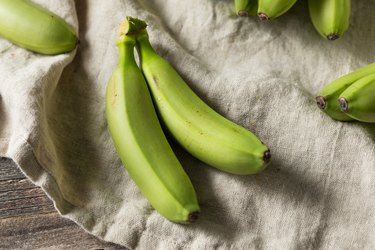
Bananas are the world's most popular fruit and though we usually think of them as being sunshine-yellow, they can vary from firm and green, to softer with plenty of brown speckles. There's been talk that an unripe banana offers more health benefits, but what's the truth about this assertion?
Tip
It’s not really a case of unripe bananas being better for you — green bananas just offer slightly different benefits to ripe ones, including being higher in resistant starch. Choose whichever type of banana color you enjoy, as they are all good for you.
Video of the Day
Banana Health Facts
The USDA advises that a medium banana provides 105 calories and 3.1g of fiber. Banana vitamins and minerals (per medium banana) include 0.4 milligrams of vitamin B6, 32 milligrams of magnesium and 422 milligrams of potassium. The Mayo Clinic says vitamin B6 is needed to help your body use protein and make red blood cells. Magnesium helps maintain heart rhythm and keeps the immune system and muscles healthy, while potassium is critical to the function of both nerve and muscle cells.
Video of the Day
The total carbohydrate content doesn't change in bananas over time, but as they ripen, the starch in them changes to sugar. People with diabetes may worry about eating bananas, but the International Tables of Glycemic Index (GI) and Glycemic Load (GL) Values (published as appendices to the December 2008 issue of Diabetes Care) suggest they need not be unduly concerned.
In fact with a GI of 51 (GL of 13) ripe bananas have only a modest effect on blood sugar. That said, unripe, or at least somewhat less soft bananas (who really wants to eat one that's hard?), may be a better option for people with diabetes. The official GI/GL tables show a "slightly underripe" banana as having a GI of just 41 and a GL of 11.
Resistant Starch in Unripe Bananas
If you like your bananas the opposite of ripe, one benefit of eating them this way is resistant starch. Harvard Health explains this is a carbohydrate found in firmer bananas that, like fiber, can't be broken down by normal digestion. Instead it passes into the bowel, where it acts as a prebiotic food for the growth of beneficial gut bacteria.
Read more: Top 10 Healthiest Fruits and Vegetables
These beneficial gut bacteria ferment the starch in the large intestine, producing short-chain fatty acids (SCFAs). The beneficial SCFAs may play a role in the prevention of chronic diseases including colitis and Crohn's disease.
A June 2018 review in Nutrition Research suggests resistant starch also has a lowering effect on total cholesterol and "bad" LDL-cholesterol, which is good news for a healthy heart. Pectin is another healthy type of fiber found in both unripe and ripe bananas, which the Cleveland Clinic says can increase satiety (fullness) and reduce blood sugar.
Brown Bananas: No Miracle Cure
You may have heard of something called a TNF banana, where TNF stands for Tumor Necrosis Factor. Stories have circulated around the internet that the brown spots on bananas contain TNF and that eating very ripe bananas or even dark brown banana skins can help correct abnormal cells in humans.
However the National Cancer Institute dismisses this by explaining that TNF is a protein made by white blood cells in response to an infection. Bananas do not have white blood cells and cannot produce TNF at all — the idea is a complete myth.
- Mayo Clinic: "Special Report: Vitamins and Minerals"
- Diabetes Care: "International Tables of Glycemic Index and Glycemic Load Values: 2008"
- Harvard Health Publishing: "Distracted Eating May Lead to Weight Gain"
- Nutrition Research: "Meta-Analysis Indicates That Resistant Starch Lowers Serum Total Cholesterol and Low-Density Cholesterol"
- Cleveland Clinic: Supplements to Help Manage Blood Sugar Health: "Pectin"
- National Cancer Institute: NCI Dictionary of Cancer Terms"
- USDA FoodData Central: "Banana, Raw"